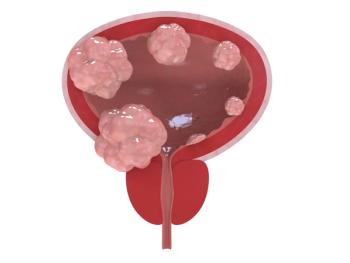
Positive Efficacy Noted With Cemiplimab/Chemotherapy in Penile Carcinoma
The phase 2 EPIC trial assessing patients with penile carcinoma met its primary end point of clinical benefit rate, with the lower bound of the confidence interval exceeding the null hypothesis limit.
Data from the phase 2 EPIC trial (ISRCTN95561634) presented at the
At 12 weeks, the clinical benefit rate (CBR) from the study treatment was 62.1% (95% CI, 44.4%-79.7%); 0 patients experienced a complete response (CR), 15 (51.7%) patients experienced a partial response (PR), and 3 (10.3%) had stable disease (SD). The objective response rate at 12 weeks was 51.7% (95% CI, 34.4%-68.6%). At 21 weeks, the CBR was 48.3% (95% CI, 31.4%-65.6%); 1 patient (3.4%) had a CR, 12 (41.4%) had PRs, and 1 (3.4%) had SD. The ORR at 21 weeks was 44.8% (95% CI, 28.4%-62.4%).
For both ORR and CBR, the 95% confidence interval lower limit was greater than the null hypothesis limit of 25%.
The median progression-free survival (PFS) was 6.2 months (95% CI, 3.7-8.7) and the median overall survival (OS) was 15.5 months (95% CI, 6.0-25.0).
“The EPIC-A trial provides important data regarding the efficacy and safety of cemiplimab in combination with platinum-based chemotherapy as a treatment for [locally advanced or metastatic penile carcinoma],” presenting study author Amit Bahl, MD, at the Bristol Haematology and Oncology Centre, University Hospitals Bristol and Weston NHS Foundation Trust, and coauthors, stated in the presentation. “These data support combination cisplatin-based chemotherapy plus cemiplimab as a first line treatment option to potentially improve outcomes in this rare cancer.”
EPIC-A was a non-randomized, open-label trial that enrolled a total of 29 patients and administered 350 mg of intravenous cemiplimab on the first day of each treatment cycle and 4 cycles of intravenous cisplatin-based chemotherapy once every 3 weeks. Patients could then transition to maintenance with up to 30 cycles of 350 mg of intravenous cemiplimab on day 1 every 3 weeks. Standard of care chemotherapy consists of either 80 mg/m2 of cisplatin on day 1 and 4000 mg/m2 fluorouracil on days 1 to 4, or 75 mg/m2 of cisplatin, 175 mg/m2 of paclitaxel (Abraxane), and 3600 mg/m2 of ifosfamide.
Eligible patients had histologically proven TxN3M0, TxN2M0, T2N1M0, T4anyN, or M1 locally advanced or metastatic carcinoma of the penis; no previous chemotherapy for treatment of penile cancer; an ECOG performance status from 0 to 2; adequate renal, liver, and bone marrow function; and measurable disease per RECIST v1.1.
The median age of patients was 61 years (range, 38-76); ECOG performance statuses were 0 (45%), 1 (48%), and 2 (7%); disease stage was locally advanced for 24% and metastatic for 76%. Locations of metastasis were lung (55.2%), bone (23.0%), and liver (6.9%). Patients received treatment for a median of 5 cycles (range, 1-34), and the median follow-up was 15.0 months (IQR, 6.2-21.6).
The primary trial end point was investigator-assessed CBR at 12 weeks. Secondary end points included safety; CBR at 1, 2, and 3 years; ORR, PFS, OS, and quality of life.
No new safety signals were identified, and the profile was consistent with previously reported data.
Adverse events (AEs) of grade 3 or higher that were chemotherapy-related were gastrointestinal disorders (13.6%), of the blood and lymphatic system (9.1%), infections and infestations (9.1%), and cardiac disorders (4.5%); cemiplimab-related AEs were infections and infestations (22.2%), gastrointestinal disorders (11.1%), immune system disorders (11.1%), and vascular disorders (11.1%).
Additionally, 23% of AEs were related to cemiplimab, and 31% were related to chemotherapy. Grade 5 AEs were observed in 2 instances; 1 was due to chemotherapy, and 0 was due to cemiplimab. Treatment discontinuation occurred in 7 patients, 4 of which were related to cemiplimab.
Reference
Bahl A, Challapalli A, Venugopal B, et al. EPIC-A: phase II trial of cemiplimab plus standard of care chemotherapy followed by maintenance cemiplimab in locally advanced or metastatic penile carcinoma. J Clin Oncol. 2025;43(suppl 5):1. doi:10.1200/JCO.2025.43.5_suppl.1
Newsletter
Stay up to date on recent advances in the multidisciplinary approach to cancer.

















































































